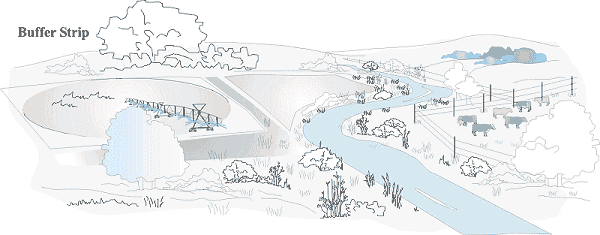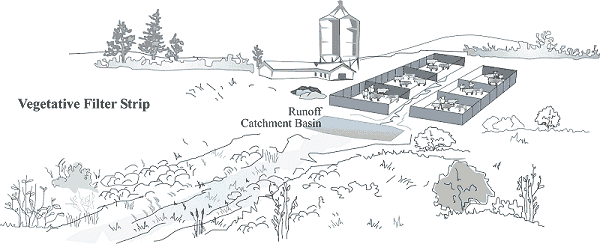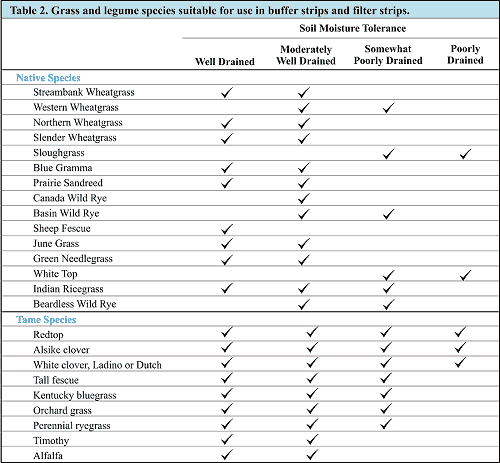| | Buffer zones | Design of the buffer zone | Maintenance of buffer zones | Beneficial management practices (BMPs)
Buffer zones are areas of land, adjacent to a water course or waterbody, kept in permanent vegetation. Buffers protect water quality by slowing the flow of water, thus facilitating the trapping of sediment, organic matter, nutrients and pesticides. The vegetation that forms an essential part of a buffer zone uses some of the trapped nutrients for growth and provides critical habitat for micro-organisms. Micro-organisms attached to the soil and vegetation in the buffer zone also use the nutrients and organic matter for their growth and reproduction, and in the process transform some contaminants into less harmful forms.
Buffer Zones
Buffer zone designs vary according to their management objectives - that is, whether they are primarily aimed at maintaining good water quality, controlling erosion, or providing wildlife habitat. This fact sheet deals with buffer strips and vegetated filter strips used primarily for water quality protection.
Buffer strips
Buffer strips border drainage ditches, irrigation canals and wetlands. They receive the diffuse or scattered runoff from non-point sources such as cropland. Flow of water through a buffer strip is generally small and only occurs following a precipitation event or during irrigation.
Vegetated filter strips
Vegetated filter strips are designed to treat runoff water that flows through them. Filter strips are more likely to receive runoff water generated from livestock operations, such as small backgrounding feedlots, winter feeding sites, calving pens and manure stockpile sites. The runoff generated by these activities contains higher concentrations of contaminants and may resemble wastewater, compared to the more diffuse runoff received by buffer strips.
In regions receiving limited precipitation, this runoff may be discharged directly to a filter strip. In areas where the frequency of precipitation events is high, a catchment basin usually precedes the filter strip and helps regulate the rate of flow of the runoff into the vegetation. A filter strip that receives a large amount of runoff at one time may not trap contaminants, because the retention time of the water in the filter strip is too short. When solids and contaminants in captured runoff are pumped to a filter strip at a slow, constant rate, enough time is provided for them to be trapped in the vegetation and soil. A catchment basin will also remove some of the organic solids generated by the livestock operations before these reach the filter strip. Otherwise, organic solids tend to be deposited in the upper portion of the filter strip where they decrease the effectiveness of the filter. Accumulation of organic solids and sediment has been documented as the major cause of filter strip failure.
Why are buffer zones important?
Benefits associated with buffer zones are many. Buffers protect water quality and reduce soil erosion. This is important for downstream water users, as the cost of water treatment will decrease when good water quality is maintained. Depending on the vegetation established, the buffer zone can be a source of forage production for the farm operation. Buffers also improve farm aesthetics. Livestock may also benefit from buffer zones. Buffers around dugouts protect water quality and increase livestock health. Studies have shown that cattle gain more weight when provided with water of good quality.

Design of the Buffer Zone
The source, quality and quantity of the runoff water must be identified to determine whether a buffer strip or vegetated filter strip is more appropriate for a particular application. The design of the buffer zone, and its effectiveness, are also dependent on slope, soil conditions, type of vegetation and management objectives.
Width and Slope - The width of buffer strips located in cropping systems should increase as slope increases. In southern Alberta, land having slopes between 0% and 5% should have a buffer at least 6 metres wide to protect water quality. If the land is irrigated, the width of the buffer strip should be increased as there will be greater runoff potential than in a dryland cropping system.
A buffer strip width of 30 metres is a recommended rule-of-thumb to provide water quality protection, forage for on farm use, and wildlife habitat.
Vegetated filter strips should be wider than buffer strips, and at least 30 metres wide, because the runoff water is concentrated to flow into a single area and has higher contaminant concentrations. The slope of the land where a vegetated filter strip is created should be:
- less than 10% or risk of erosion will increase
- more than 1% or risk of ponding will increase.
Regardless of the width of the filter strip, the effluent should never be released directly to a water body if water quality is unsuitable for such discharge.
Soil texture
Soil texture also influences the design and effectiveness of buffer zones. Coarse-textured soils allow more infiltration of runoff water compared to fine-textured soils. If soils are fine-textured or compacted, infiltration rates are reduced and the retention time of the runoff in the buffer is shortened. This decreases the contact time of runoff water with soils, vegetation and micro-organisms, reducing the effectiveness of the filter. Thus the width or length of the buffer should be increased to compensate for compacted or fine-textured soils.
The depth to groundwater should also be determined, particularly where coarse-textured soils are dominant. Vegetated filter strips should be constructed at least 1 metre above the seasonal high groundwater table.

Vegetation
The type of vegetation established in the buffer depends on the land manager’s objectives. Buffer or filter strips may be seeded with a mixture of forages that could be harvested as feed for livestock. A mixture of grasses, shrubs, and trees may be used to border a waterway if improved aesthetics, wind protection, or wildlife habitat are desired. Table 1 provides a summary of some native and tame forage species suitable for use in a buffer strip or vegetated filter strip.
Generally, the vegetation chosen for use in the buffer zone should form an even, dense mat and should be able to tolerate periodic flooding. A minimum of 15 cm of stubble should be maintained following harvest or mowing, to allow some degree of filtering while the vegetation is re-established. Vegetation should be sown across the slope of the buffer between March 1 and May 1, or between August 1 and September 1.
Season
Seasonal variations influence the buffer zone’s ability to effectively filter runoff water. Buffers are not effective in winter and early spring. Temperatures below 5° C reduce microbial activity and frozen soils prevent infiltration of runoff water and decrease retention time in the buffer.
Where a vegetated filter strip is created, a catchment basin is particularly important to prevent contaminants reaching water bodies and streams in the winter months.

Maintenance of Buffer Zones
Buffer zones require some degree of maintenance to ensure their effectiveness and durability. A vegetative filter strip generally requires more attention than a buffer strip due to the nature of the runoff water received. Buffers should be inspected regularly, especially after intense rains or runoff events that may deposit large amounts of sediment or debris on the filter. The development of erosion channels should be minimized and repaired immediately. Bare spots in the filter should be re-seeded. Vegetation can be mowed to 15 cm in height and removed from the site two to three times a year. Mowed forage may be used as feed for livestock. Noxious weeds should be monitored and controlled.
Beneficial Management Practices (BMPs)
Buffer zones should be used in combination with other BMPs to protect water quality. BMPs that have long-term benefits and can be easily implemented include:
- using appropriate manure application rates that meet crop requirements and incorporating manure within 48 hours;
- applying manure at least 30 m (100 ft) from any surface water;
- using shelterbelts to control wind erosion; providing off-stream watering for cattle;
- limiting cattle access to surface water; and
- diverting clean water run-on around all livestock operations to limit the amount of water contacting the manure.
This fact sheet is one of a series of information bulletins on agriculture and resource management produced by the Irrigation Branch, Alberta Agriculture and Food.
If you would like to discuss how you can improve water quality through the use of buffer zones on your operation, contact Sandi Riemersma 403-381-5893, or use the Alberta Government Riteline, toll-free at 310-0000. |
|